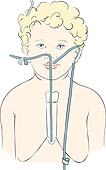Pediatric NGT
watch this video
To evaluate the effects of nasogastric tube insertion and different nasogastric tube sizes on gastroesophageal reflux in children.
Methods: During a prospective randomized study, 29 patients aged 1 month to 4 years (median, 9 months) underwent 24 hours of continuous esophageal pH monitoring to rule out gastroesophageal reflux as the cause of severe pulmonary problems. Each patient was monitored without nasogastric tube for 16 hours (baseline), and thereafter the first nasogastric tube, small (8-Fr) or large (10-Fr or 12-Fr), was placed. Four hours later, the original nasogastric tube was replaced by a new one of large (instead of small) size or of small (instead of large) size. We selected the times of wakefulness in these study periods and compared the number of reflux episodes (NREs), the number of reflux episodes that lasted more than 5 minutes (NRE > 5), and the percentage of time with esophageal pH less than 4 (PTP < 4).
Results: The 12-Fr group in comparison with the 8-Fr group and baseline showed significant difference (P < 0.05) in the NRE>5 and PTP<4 parameters. No significant differences were found when comparing 8-Fr versus 10-Fr groups and baseline. In children with (n = 20) and without (n = 9) gastroesophageal reflux, comparison of the various reflux parameters between baseline and the different sizes of nasogastric tubes showed the same results.
Conclusions: Size of the nasogastric tubes is a significant factor in predisposing the child to gastroesophageal reflux. Large nasogastric tubes interfere with the clearance of the refluxed acid from the esophagus.



 8:14 AM
8:14 AM
 Unknown
Unknown


 Posted in:
Posted in:
0 comments:
Post a Comment